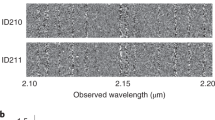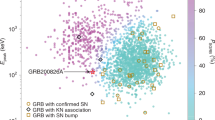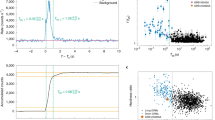Abstract
Gamma-ray bursts (GRBs) and their afterglows are the most brilliant transient events in the Universe. Both the bursts themselves and their afterglows have been predicted to be visible out to redshifts of z ≈ 20, and therefore to be powerful probes of the early Universe1,2. The burst GRB 000131, at z = 4.50, was hitherto the most distant such event identified3. Here we report the discovery of the bright near-infrared afterglow of GRB 050904 (ref. 4). From our measurements of the near-infrared afterglow, and our failure to detect the optical afterglow, we determine the photometric redshift of the burst to be  (refs 5–7). Subsequently, it was measured8 spectroscopically to be z = 6.29 ± 0.01, in agreement with our photometric estimate. These results demonstrate that GRBs can be used to trace the star formation, metallicity, and reionization histories of the early Universe.
(refs 5–7). Subsequently, it was measured8 spectroscopically to be z = 6.29 ± 0.01, in agreement with our photometric estimate. These results demonstrate that GRBs can be used to trace the star formation, metallicity, and reionization histories of the early Universe.
Similar content being viewed by others
Main
At 01:51:44 Universal Time (ut) on 4 September 2005, Swift's Burst Alert Telescope (BAT) detected GRB 050904 and 81 seconds later a 4′-radius localization was distributed to observers on the ground. Swift's X-Ray Telescope (XRT) automatically slewed to the BAT localization and 76 minutes after the burst a 6″-radius XRT localization was distributed.9
Over the next few hours, we observed the XRT localization at both near-infrared (NIR) and visible wavelengths (Table 1). In the NIR, we discovered a bright (J ≈ 17.4 mag at 3.1 hours after the burst) and fading source within the XRT localization using the 4.1-m Southern Observatory for Astrophysical Research (SOAR) telescope on top of Cerro Pachon in Chile (Fig. 1).4
Left, NIR discovery image of the bright (J = 17.36 ± 0.04 mag) afterglow of GRB 050904 from 4.1-m SOAR on top of Cerro Pachon, Chile. Middle, near-simultaneous non-detection of the afterglow at visible wavelengths (unfiltered, calibrated to Rc > 20.1 mag) from one of the six 0.41-m PROMPT telescopes that we are building on top of Cerro Tololo, which is only 10 km away from Cerro Pachon. Right, colour composite (r′i′z′) image of the afterglow 3.2 days after the burst from 8.1-m Gemini South, which is also on top of Cerro Pachon.
However, at visible wavelengths we did not detect the afterglow to relatively deep limiting magnitudes using one of the six 0.41-m Panchromatic Robotic Optical Monitoring and Polarimetry Telescopes (PROMPT)10 that we are building on top of Cerro Tololo, which is only 10 km away from Cerro Pachon4, the 60-inch telescope at Palomar Observatory in California11, and the 3.5-m telescope at Calar Alto Observatory in Spain. Nor did we detect the afterglow with the 0.30-m Burst Observer and Optical Transient Exploring System (BOOTES)12 1B telescope in El Arenosillo, Spain, which began imaging the field only 2.1 minutes after the burst13. This implies that the GRB either occurred at a very high redshift or was very heavily extinguished by dust4.
Between about 3 hours and about 0.5 days after the burst, the fading of the afterglow appears to be well described by a power law of index  (Fig. 2)5,6. However, after this time the fading appears to have slowed to a temporal index of
(Fig. 2)5,6. However, after this time the fading appears to have slowed to a temporal index of  (refs 7, 14, 15). A single power-law description is ruled out at the 3.7σ credible level. One possible explanation is that our initial SOAR observations caught the tail end of a reverse shock that had been stretched in time by a factor of 7.29 owing to cosmological time dilation. Even so, the reverse shock would still be at least a few times longer-lived in the source frame than the reverse shocks of GRBs 990123 and 021211 (refs 16, 17). Another possibility is that we are undersampling a light curve that is undergoing temporal variations, such as in the afterglows of GRBs 021004 and 030329 (refs 18, 19). Indeed, the X-ray afterglow is extremely variable at these times20.
(refs 7, 14, 15). A single power-law description is ruled out at the 3.7σ credible level. One possible explanation is that our initial SOAR observations caught the tail end of a reverse shock that had been stretched in time by a factor of 7.29 owing to cosmological time dilation. Even so, the reverse shock would still be at least a few times longer-lived in the source frame than the reverse shocks of GRBs 990123 and 021211 (refs 16, 17). Another possibility is that we are undersampling a light curve that is undergoing temporal variations, such as in the afterglows of GRBs 021004 and 030329 (refs 18, 19). Indeed, the X-ray afterglow is extremely variable at these times20.
Following the formalism of Frail et al.26, given GRB 050904's redshift and fluence27 the non-detection of a jet break in the light curve prior to 2.3 days after the burst implies that the opening/viewing angle of the jet is ≳3° and that the total energy that was released in γ rays is ≳5 × 1050 erg. The Z-band measurement (unfilled circle) is a factor of three below the fitted model, but this appears to be real and temporal in nature (Table 1). Error bars are s.e.m. Downward arrow indicates upper limit.
Using these temporal indices to scale all of our measurements to a common time, except for a Z-band (0.84–0.93 µm) measurement from 11.4 hours after the burst (Table 1), we plot the spectral flux distribution of the afterglow in Fig. 3. In the NIR, the spectral index is  However, the spectral index between NIR and visible wavelengths is steeper than -5.9. This is too sharp a transition to be explained by dust extinction alone5,21. However, a small amount of extinction cannot be ruled out and is probably present (Fig. 3).
However, the spectral index between NIR and visible wavelengths is steeper than -5.9. This is too sharp a transition to be explained by dust extinction alone5,21. However, a small amount of extinction cannot be ruled out and is probably present (Fig. 3).
Measurements have been scaled to 10.6 hours after the burst using our best-fit light curve. We model the spectrum as a power law with negligible emission blueward of Lyα. Shallower intrinsic power-law spectra can be inferred with the addition of source-frame dust. If one assumes that the jet is propagating through either a constant-density or wind-swept medium with the synchrotron electron cooling frequency either redward or blueward of the observed frequencies, the fitted temporal index  implies an electron energy distribution index between
implies an electron energy distribution index between  and
and  and an intrinsic spectral index between
and an intrinsic spectral index between  and
and  (refs 28, 29). This is shallower than the fitted spectral index
(refs 28, 29). This is shallower than the fitted spectral index  which suggests that source-frame dust is probably present. However, only a small amount is required to explain such a difference at these source-frame frequencies. This cannot explain the sharp drop in spectral flux in and blueward of the z′ band5,21. We take Galactic E(B - V) = 0.060 mag (ref. 30). Error bars are s.e.m. Downward arrows indicate upper limits.
which suggests that source-frame dust is probably present. However, only a small amount is required to explain such a difference at these source-frame frequencies. This cannot explain the sharp drop in spectral flux in and blueward of the z′ band5,21. We take Galactic E(B - V) = 0.060 mag (ref. 30). Error bars are s.e.m. Downward arrows indicate upper limits.
Assuming negligible emission blueward of Lyα, we measure a photometric redshift of  (refs 5, 6–7), which is consistent with the spectroscopic redshift of z = 6.29 ± 0.01 (ref. 8). For H0 = 71 km s-1 Mpc-1, Ωm = 0.27, and ΩΛ = 0.73 (ref. 22), this corresponds to about 900 million years after the Big Bang, when the Universe was about 6% of its current age. The next-most-distant GRB that has been identified occurred at z = 4.50 (ref. 3), which was about 500 million years later, when the Universe was about 10% of its current age.
(refs 5, 6–7), which is consistent with the spectroscopic redshift of z = 6.29 ± 0.01 (ref. 8). For H0 = 71 km s-1 Mpc-1, Ωm = 0.27, and ΩΛ = 0.73 (ref. 22), this corresponds to about 900 million years after the Big Bang, when the Universe was about 6% of its current age. The next-most-distant GRB that has been identified occurred at z = 4.50 (ref. 3), which was about 500 million years later, when the Universe was about 10% of its current age.
One of the most exciting aspects of this discovery is the brightness of the afterglow: extrapolating back to a few minutes after the burst, the afterglow must have been exceptionally bright redward of Lyα for the robotic 0.25-m TAROT telescope to detect it in unfiltered visible-light observations23. Extrapolating our J-band light curve back to these times yields J ≈ 11–12 mag. This suggests that by pairing visible-light robotic telescopes with NIR robotic telescopes, and these with larger telescopes that are capable of quick-response NIR spectroscopy, all preferably at the same site so that they are subject to the same observing conditions, at least some very-high-redshift afterglows will be discovered, identified, and their NIR spectrum taken while they are still sufficiently bright to serve as a powerful probe of the conditions of the early Universe10.
References
Lamb, D. Q. & Reichart, D. E. Gamma-ray bursts as a probe of the very high redshift Universe. Astrophys. J. 536, 1–18 (2000)
Ciardi, B. & Loeb, A. Expected number and flux distribution of gamma-ray burst afterglows with high redshifts. Astrophys. J. 540, 687–696 (2000)
Andersen, M. I. et al. VLT identification of the optical afterglow of the gamma-ray burst GRB 000131 at z = 4.50. Astron. Astrophys. 364, L54–L61 (2000)
Haislip, J. et al. GRB 050904: SOAR/PROMPT observations. GCN Circ. 3913 (2005)
Haislip, J. et al. GRB 050904: possible high-redshift GRB. GCN Circ. 3914 (2005)
Reichart, D. GRB 050904: environmental constraints. GCN Circ. 3915 (2005)
Haislip, J. et al. GRB 050904: SOAR YJ and PROMPT Ic observations. GCN Circ. 3919 (2005)
Kawai, N., Yamada, T., Kosugi, G., Hattori, T. & Aoki, K. GRB 050904: Subaru optical spectroscopy. GCN Circ. 3937 (2005)
Cummings, J. et al. GRB050904: Swift-BAT detection of a probable burst. GCN Circ. 3910 (2005)
Reichart, D. et al. PROMPT: panchromatic robotic optical monitoring and polarimetry telescopes. Nuovo Cim. 28, 767–770 (2005)
Fox, D. B. & Cenko, S. B. GRB050904: P60 observations. GCN Circ. 3912 (2005)
Castro-Tirado, A. J. et al. Simultaneous and optical follow-up GRB observations by BOOTES. Nuovo Cim. 28, 715–718 (2005)
Jelinek, M. et al. GRB 050904: Bootes early R-band detection. GCN Circ. 3929 (2005)
D'Avanzo, P. et al. GRB 050904: NIR object inside the XRT error box. GCN Circ. 3921 (2005)
D'Avanzo, P. et al. GRB 050904: more VLT NIR observations. GCN Circ. 3930 (2005)
Akerlof, C. et al. Observations of contemporaneous optical radiation from a gamma-ray burst. Nature 398, 400–402 (1999)
Li, W., Filippenko, A. V., Chornock, R. & Jha, S. The early light curve of the optical afterglow of GRB 021211. Astrophys. J. 586, L9–L12 (2003)
Fox, D. W. et al. Early optical emission from the γ-ray burst of 4 October 2002. Nature 422, 284–286 (2003)
Price, P. A. et al. The bright optical afterglow of the nearby γ-ray burst of 29 March 2003. Nature 423, 844–847 (2003)
Watson, D. et al. Outshining the Quasars at reionization: The X-ray spectrum and lightcurve of the redshift 6.29 γ-ray burst GRB 050904. Astrophys. J. (submitted)
Reichart, D. E. Dust extinction curves and Lyα forest flux deficits for use in modeling gamma-ray burst afterglows and all other extragalactic point sources. Astrophys. J. 553, 235–253 (2001)
Spergel, D. N. et al. First-year Wilkinson microwave anisotropy probe (WMAP) observations: Determination of cosmological parameters. Astrophys. J. Suppl. Ser. 148, 175–194 (2003)
Klotz, A., Boer, M. & Atteia, J. L. GRB 050904: TAROT optical measurements. GCN Circ. 3917 (2005)
Smith, J. A. et al. The u′g′r′i′z′ standard-star system. Astron. J. 123, 2121–2144 (2002)
Draine, B. T. Gamma-ray bursts in molecular clouds: H2 absorption and fluorescence. Astrophys. J. 532, 273–280 (2000)
Frail, D. A. et al. Beaming in gamma-ray bursts: Evidence for a standard energy reservoir. Astrophys. J. 562, L55–L58 (2001)
Sakamoto, T. et al. GRB 050904 BAT refined analysis of complete data set. GCN Circ. 3938 (2005)
Sari, R., Piran, T. & Narayan, R. Spectra and light curves of gamma-ray burst afterglows. Astrophys. J. 497, L17–L20 (1998)
Chevalier, R. A. & Li, Z.-Y. Gamma-ray burst environments and progenitors. Astrophys. J. 520, L29–L32 (1999)
Schlegel, D. J., Finkbeiner, D. P. & Davis, M. Maps of dust infrared emission for use in estimation of reddening and cosmic microwave background radiation foregrounds. Astrophys. J. 500, 525–553 (1998)
Acknowledgements
D.E.R. gratefully acknowledges support from NSF's MRI, CAREER, PREST and REU programmes, NASA's APRA, Swift GI and IDEAS programmes, and especially L. Goodman and H. Cox. D.E.R. also thanks W. Christiansen, B. Carney, and everyone who has worked to make SOAR a reality over the past 19 years. A.L. and N.T. thank B. Cavanagh and A. Adamson of the JAC for their speedy assistance in acquiring and reducing the UKIRT WFCAM data. A.J.C.-T. thanks INTA and CSIC for their support of BOOTES and AYA (including FEDER funds). R.H. and P.K. acknowledge support from GA AV CR and ESA PECS.
Author information
Authors and Affiliations
Corresponding author
Ethics declarations
Competing interests
Reprints and permissions information is available at npg.nature.com/reprintsandpermissions. The authors declare no competing financial interests.
Rights and permissions
About this article
Cite this article
Haislip, J., Nysewander, M., Reichart, D. et al. A photometric redshift of z = 6.39 ± 0.12 for GRB 050904. Nature 440, 181–183 (2006). https://doi.org/10.1038/nature04552
Received:
Accepted:
Issue Date:
DOI: https://doi.org/10.1038/nature04552
This article is cited by
-
Exceptionally bright optical emission from a rare and distant gamma-ray burst
Nature Astronomy (2023)
-
Detection of GRBs at high altitudes with a prototype water Cherenkov detector using single-particle technology
Astrophysics and Space Science (2020)
Comments
By submitting a comment you agree to abide by our Terms and Community Guidelines. If you find something abusive or that does not comply with our terms or guidelines please flag it as inappropriate.






